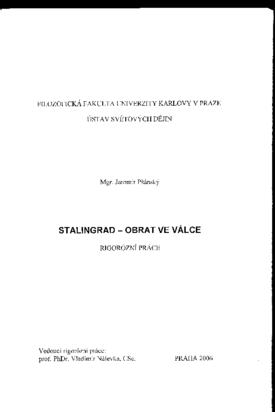Stalingrad - obrat ve válce
Stalingrad - the war turnover
rigorous thesis (DEFENDED)

View/
Permanent link
http://hdl.handle.net/20.500.11956/8489Identifiers
Study Information System: 27611
Collections
- Kvalifikační práce [23976]
Author
Advisor
Referee
Tajovský, Ladislav
Faculty / Institute
Faculty of Arts
Discipline
History
Department
Institute of General History
Date of defense
14. 2. 2007
Publisher
Univerzita Karlova, Filozofická fakultaLanguage
Czech
Grade
Pass
Práce "Stalingrad- obrat ve válce" se zabývá pncmami, průběhem a důsledky největší bitvy vojenských dějin. Text je rozčleněn do jedenácti kapitol. Úvod obsahuje stručné zhodnocení použité literatury, následuje stručné vylíčení prvního roku války na východní frontě, až po porážku německé armády před Moskvou. Těžištěm je ale vlastní průběh a výsledek zápasu o pevnost na Volze. Pozornost je věnována i donedávna utajované operaci Mars, která by v případě úspěchu odsunula stalingradskou protiofenzívu až na druhé místo. Práce je zpracována chronologicky s důrazem na každodenní utrpení vojáků a civilistů. Cílem je podat pokud možno plastický obraz východního bojiště, podepřený příslušnými odkazy na publikace, uvedené v seznamu použité literatury. Autor se pokusil překonat černobílé vidění válečného konfliktu a přispět tak k porozumění jedné z klíčových kapitol historie druhé světové války.
The work "Stalingrad - the turning point of the war", describes reasons, proces s and results of the largest battle of the mil i tary hi s tory. The text i s divided into eleven chapters. The introduction contains a brief analys i s of used literature followed by the brief portrayal of the first year of the war on the eastern front until the defeating of the German army at Moscow. But the emphasis of the work i s the proces s and the result of the struggle of the fortress on Volha. The attention is paid also to the operation Mars, which was secret until relatively recent time and which would (in the case of succes) shade the Stalingrad counter-offensive. The method of the work is chronological with the accent to the everyday suffering of soldiers and non-combatants. The purpose i s to show a various view of the eastern field, supported by the relevant citations of publications, which are stated in a list of used literature. The author tried to overcome the black-and-white view on the war conflict and contribute to the understanding of the o ne of the second world war key moments.
